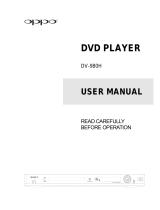
GOLDMUND EIDOS REFERENCE BLUE – Blu-Ray Player -
20
8 SETTINGS (Ctd.)
6. Language: Configures language preferences. This menu contains the following
sub-items:
• Player Language – Allows you to choose the language for the player’s Setup
Menu and the on-screen display. Currently the player supports 9 languages.
• Disc Menu Language – Allows you to choose the preferred language for
displaying DVD and Blu-ray Disc menus. If a disc menu of the selected language is
available, that menu will be shown instead of the default disc menu.
• Audio Language – Allows you to choose the preferred audio language for DVD
and Blu-ray Discs. If an audio track of the selected language is available on the
disc, the audio track will be played back.
• Subtitle Language – Allows you to choose the preferred subtitle language for
DVDs. If a subtitle of the selected language is available, it will be displayed. When
Auto is selected, the subtitle display is determined by the disc.
Video Setup
The Video Setup section of the Setup Menu allows you to configure video output
options.
1. Picture Adjustment: Adjusts picture control settings. The Eidos Reference Blue
provides a wide array of picture controls. Please refer to the Picture Adjustment
section for more details about each control.
2. Dual HDMI Output: Allows you to select the output mode when both HDMI Output
ports are in use. If only one HDMI Output is active, this selection will not apply.
• Split A/V (recommended) – Use HDMI 1 OUT as the dedicated video output port
and HDMI 2 OUT as the dedicated audio output port. This setting will ensure the
best possible picture quality and the highest possible audio resolution.
NOTE
The player can automatically adjust the
resolution of digital audio and video signals
depending on the capabilities of the
connected television and receivers.
For HDMI 1 OUT, the dedicated QDEO
video processor will be used unless Source
Direct is selected, in which case QDEO is
bypassed.
In Split A/V mode, HDMI 1 OUT has video
only with no audio, but HDMI 2 OUT will
have audio and possibly video. This is
because HDMI embeds audio into video
data so there must always be a video signal,
even if it’s only a blank screen, to carry
audio through.
NOTE
If your preferred language is not listed in the
Audio, Subtitle or Disc Menu options, select
“Other” and enter the Language provided by
your official Goldmund representative.































